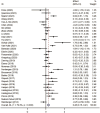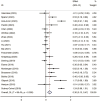Association of soluble TREM2 with Alzheimer's disease and mild cognitive impairment: a systematic review and meta-analysis
- PMID: 38841103
- PMCID: PMC11150578
- DOI: 10.3389/fnagi.2024.1407980
Association of soluble TREM2 with Alzheimer's disease and mild cognitive impairment: a systematic review and meta-analysis
Abstract
Objective: Soluble triggering receptor expressed on myeloid cells 2 (sTREM2) is a potential neuroinflammatory biomarker linked to the pathogenesis of Alzheimer's disease (AD) and mild cognitive impairment (MCI). Previous studies have produced inconsistent results regarding sTREM2 levels in various clinical stages of AD. This study aims to establish the correlation between sTREM2 levels and AD progression through a meta-analysis of sTREM2 levels in cerebrospinal fluid (CSF) and blood.
Methods: Comprehensive searches were conducted in PubMed, Embase, Web of Science, and the Cochrane Library to identify observational studies reporting CSF and blood sTREM2 levels in AD patients, MCI patients, and healthy controls. A random effects meta-analysis was used to calculate the standardized mean difference (SMD) and 95% confidence intervals (CIs).
Results: Thirty-six observational studies involving 3,016 AD patients, 3,533 MCI patients, and 4,510 healthy controls were included. CSF sTREM2 levels were significantly higher in both the AD [SMD = 0.28, 95% CI (0.15, 0.41)] and MCI groups [SMD = 0.30, 95% CI (0.13, 0.47)] compared to the healthy control group. However, no significant differences in expression were detected between the AD and MCI groups [SMD = 0.09, 95% CI (-0.09, 0.26)]. Furthermore, increased plasma sTREM2 levels were associated with a higher risk of AD [SMD = 0.42, 95% CI (0.01, 0.83)].
Conclusion: CSF sTREM2 levels are positively associated with an increased risk of AD and MCI. Plasma sTREM2 levels were notably higher in the AD group than in the control group and may serve as a promising biomarker for diagnosing AD. However, sTREM2 levels are not effective for distinguishing between different disease stages of AD. Further investigations are needed to explore the longitudinal changes in sTREM2 levels, particularly plasma sTREM2 levels, during AD progression.
Systematic review registration: https://www.crd.york.ac.uk/prospero/display_record.php?ID=CRD42024514593.
Keywords: Alzheimer’s disease; meta-analysis; mild cognitive impairment; neuroinflammation; soluble TREM2.
Copyright © 2024 Wang, Zhan, Zhu, Yang and Pei.
Conflict of interest statement
The authors declare that the research was conducted in the absence of any commercial or financial relationships that could be construed as a potential conflict of interest.
Figures






Similar articles
-
Soluble TREM2 changes during the clinical course of Alzheimer's disease: A meta-analysis.Neurosci Lett. 2018 Nov 1;686:10-16. doi: 10.1016/j.neulet.2018.08.038. Epub 2018 Aug 29. Neurosci Lett. 2018. PMID: 30171911
-
Association between Cerebrospinal Fluid Soluble TREM2, Alzheimer's Disease and Other Neurodegenerative Diseases.J Clin Med. 2023 May 22;12(10):3589. doi: 10.3390/jcm12103589. J Clin Med. 2023. PMID: 37240695 Free PMC article.
-
Soluble TREM2 Concentrations in the Cerebrospinal Fluid Correlate with the Severity of Neurofibrillary Degeneration, Cognitive Impairment, and Inflammasome Activation in Alzheimer's Disease.Neurol Int. 2023 Jul 7;15(3):842-856. doi: 10.3390/neurolint15030053. Neurol Int. 2023. PMID: 37489359 Free PMC article.
-
Effects of Electronic Serious Games on Older Adults With Alzheimer's Disease and Mild Cognitive Impairment: Systematic Review With Meta-Analysis of Randomized Controlled Trials.JMIR Serious Games. 2024 Jul 31;12:e55785. doi: 10.2196/55785. JMIR Serious Games. 2024. PMID: 39083796 Free PMC article. Review.
-
Blood levels of circulating methionine components in Alzheimer's disease and mild cognitive impairment: A systematic review and meta-analysis.Front Aging Neurosci. 2022 Jul 22;14:934070. doi: 10.3389/fnagi.2022.934070. eCollection 2022. Front Aging Neurosci. 2022. PMID: 35936764 Free PMC article.
Cited by
-
Navigating the Alzheimer's Biomarker Landscape: A Comprehensive Analysis of Fluid-Based Diagnostics.Cells. 2024 Nov 18;13(22):1901. doi: 10.3390/cells13221901. Cells. 2024. PMID: 39594648 Free PMC article. Review.
-
Neuroinflammatory fluid biomarkers in patients with Alzheimer's disease: a systematic literature review.Mol Psychiatry. 2025 Jun;30(6):2783-2798. doi: 10.1038/s41380-025-02939-9. Epub 2025 Mar 6. Mol Psychiatry. 2025. PMID: 40050444 Free PMC article.
References
Publication types
LinkOut - more resources
Full Text Sources

